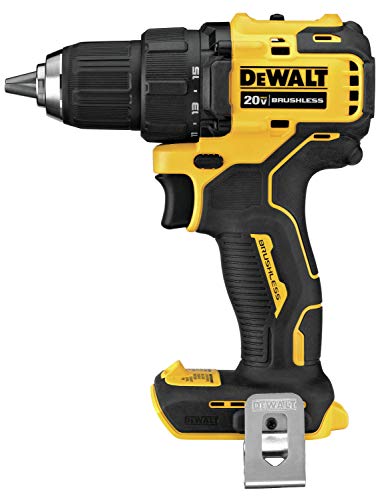Homefixerhub.com is supported by its readers. When you purchase through links on our site, we may earn an affiliate commission. Also, as an Amazon affiliate, we earn from qualifying purchases.
When it comes to power tools, one question that often arises is whether a brushless drill is better than a brushed one. The answer, as with many things, is that it depends on your needs and preferences. However, there are some key differences between the two types of drills that may help you make an informed decision.
Brushed drills have been around for decades and are the more traditional type of drill. They use carbon brushes to transfer electrical current to the motor, which in turn rotates the drill bit. Brushless drills, on the other hand, use an electronic circuit board to control the flow of current to the motor. This means that there are no brushes to wear out over time, leading to less maintenance and a longer lifespan. Additionally, brushless drills are often more efficient and powerful than brushed drills, making them a popular choice among professionals.
Let’s delve into the specifics and determine which drill is superior: the brushless or brushed option?
Contents
What are Brushed and Brushless Drills?
If you’re in the market for a new drill, you may have come across the terms “brushed” and “brushless” and wondered what they mean. Essentially, these terms refer to the type of motor in the drill. Let’s take a closer look at each type:
Brushed Drills
Brushed drills have been around for a long time and are the more traditional type of drill. They have a motor that uses brushes to transfer electrical current to the spinning armature. The brushes are made of carbon and can wear out over time, which can lead to reduced performance and the need for replacement. Brushed drills tend to be less expensive than brushless drills, but they also tend to be less efficient and have a shorter lifespan.
Brushless Drills
Brushless drills, on the other hand, use a more advanced motor that doesn’t rely on brushes. Instead, they use electronic controllers to adjust the current and voltage of the motor, which allows for more precise control and better efficiency. Brushless drills tend to be more expensive than brushed drills, but they also tend to be more powerful, longer-lasting and require less maintenance. They’re also often lighter and more compact than brushed drills, making them a popular choice for professionals and DIYers alike.
Overall, the choice between a brushed and brushless drill depends on your needs and budget. If you’re a casual DIYer who only needs a drill for occasional use, a brushed drill may be a good choice. However, if you’re a professional who needs a powerful, reliable, and long-lasting tool, a brushless drill is likely the way to go.

- 18-volt lithium-ion battery provides long-lasting power
- Brushless motor delivers efficient and durable performance
- Compact size for easy maneuverability in tight spaces
- 1/2 inch metal chuck for strong bit grip
- Adjustable clutch with 18 settings for precise drilling and driving
- LED light illuminates the work area for improved visibility

- Compact and lightweight design for easy handling and maneuverability
- Powerful brushless motor delivers high performance and long runtime
- A 1/2-inch ratcheting chuck provides a secure grip on bits for improved accuracy
- Ergonomic handle with rubber over-mold reduces user fatigue and enhances comfort
- LED work light illuminates dark workspaces for increased visibility and precision.
- Cheapest of the bunch, and my personal favorite!

- Compact and ergonomic design for comfortable handling
- Variable 2-speed design (0-600 & 0-1,900 RPM) for a wide range of drilling and driving applications
- 4-pole motor delivers up to 480 in. lbs. of maximum torque
- All-metal gear construction for durability and long tool life
- Dual LED lights illuminate the work area for improved visibility
- Compatible with Makita 18V Lithium-Ion batteries with a fast charging time
Differences Between Brushed and Brushless Drills
Mechanism
Brushed and brushless drills have different mechanisms. Brushed drills use carbon brushes to transfer power from the battery to the motor. The brushes make contact with the commutator, which is a rotating switch that changes the direction of the current flowing through the motor. This process creates friction, which causes the brushes to wear out over time.
On the other hand, brushless drills use an electronic controller to adjust the current flowing through the motor. The controller uses sensors to detect the position of the rotor and adjusts the current accordingly. This process eliminates the need for brushes and reduces friction, resulting in less wear and tear on the motor.
Performance
Brushless drills have several advantages over brushed drills when it comes to performance. Firstly, brushless drills are more efficient because they waste less energy as heat. Secondly, brushless drills can deliver more torque and speed because they can adjust the current flowing through the motor more precisely. Thirdly, brushless drills have a longer lifespan because they have fewer moving parts and less wear and tear on the motor.
Maintenance
Brushed drills require more maintenance than brushless drills because the brushes wear out over time and need to be replaced. Additionally, the commutator can become dirty or damaged, which can affect the performance of the drill. Brushless drills, on the other hand, require less maintenance because they have fewer moving parts and no brushes to replace.
Advantages of Brushless Drills
If you’re in the market for a new drill, you may be wondering whether a brushless drill is better than a brushed one. While both types of drills have their pros and cons, brushless drills offer several advantages that make them a great choice for many DIYers and professionals alike.
Efficiency
One of the main advantages of brushless drills is their efficiency. Unlike brushed drills, which rely on brushes to transfer power from the motor to the drill bit, brushless drills use an electronic controller to adjust the voltage and current to the motor in real-time. This means that brushless drills are more efficient, as they waste less energy in the form of heat and friction. As a result, brushless drills can typically run longer on a single battery charge than brushed drills.
Durability
Another advantage of brushless drills is their durability. Because they don’t have brushes, which can wear out and require replacement over time, brushless drills tend to last longer than brushed drills. Additionally, brushless drills are less likely to overheat or suffer from other types of motor damage, as their electronic controllers can detect and adjust for changes in load and temperature.
Power
Finally, brushless drills are often more powerful than brushed drills. This is because brushless drills can deliver more torque and RPMs without overheating or bogging down. Additionally, brushless drills can maintain their power output even as the battery charge depletes, whereas brushed drills may experience a drop-off in power as the battery drains.
Overall, if you’re looking for a drill that is efficient, durable, and powerful, a brushless drill is definitely worth considering. While they may be more expensive than brushed drills, the benefits they offer can make them a worthwhile investment in the long run.
Disadvantages of Brushless Drills
Cost
One of the main disadvantages of brushless drills is their cost. Generally, they are more expensive than their brushed counterparts. This is because they use more advanced technology and components, such as electronic speed controllers and rare-earth magnets. However, the price difference is often justified by their increased efficiency, durability, and performance.
Complexity
Brushless drills are also more complex than brushed drills. They require more sophisticated electronics and control systems to operate, which can make them more difficult to repair or maintain. Additionally, they may have more components that can fail or malfunction, such as sensors or circuit boards. However, many manufacturers offer warranties or service plans that can help mitigate these risks.
Compatibility
Finally, brushless drills may not be compatible with all types of batteries or chargers. Because they require specific voltage and current levels to operate optimally, they may not work with older or lower-quality power sources. Additionally, some brushless drills may require proprietary batteries or chargers, which can limit your options and increase your costs. However, many manufacturers offer adapters or compatibility guides to help you choose the right components for your drill.
Conclusion
After weighing the pros and cons of both brushed and brushless drills, it is clear that brushless drills offer several advantages over their brushed counterparts. With their longer lifespan, greater efficiency, and increased power, brushless drills are the superior choice for both DIY enthusiasts and professionals.
While brushed drills may be more affordable in the short term, the need for frequent maintenance and replacement of brushes can quickly add up. Brushless drills, on the other hand, require little to no maintenance and can last up to 10 times longer than brushed drills.
Additionally, brushless drills are more efficient, meaning they can run longer on a single battery charge and provide more power with less energy consumption. This makes them a great choice for heavy-duty tasks that require sustained use over an extended period of time.
Overall, if you are in the market for a new drill, it is highly recommended that you invest in a brushless model. While the initial cost may be higher, the long-term benefits and savings make it well worth the investment.
Amazon and the Amazon logo are trademarks of Amazon.com, Inc, or its affiliates.



